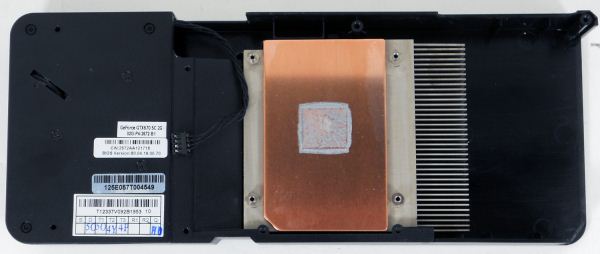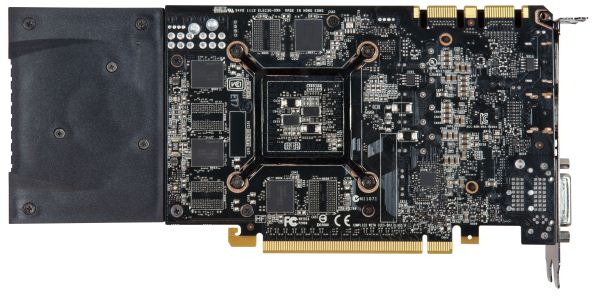NVIDIA GeForce GTX 670 Review Feat. EVGA: Bringing GK104 Down To $400
by Ryan Smith on May 10, 2012 9:00 AM ESTMeet The GeForce GTX 670
Because of the relatively low power consumption of GK104 relative to past high-end NVIDIA GPUs, NVIDIA has developed a penchant for small cards. While the GTX 680 was a rather standard 10” long, NVIDIA also managed to cram the GTX 690 into the same amount of space. Meanwhile the GTX 670 takes this to a whole new level.
We’ll start at the back as this is really where NVIDIA’s fascination with small size makes itself apparent. The complete card is 9.5” long, however the actual PCB is far shorter at only 6.75” long, 3.25” shorter than the GTX 680’s PCB. In fact it would be fair to say that rather than strapping a cooler onto a card, NVIDIA strapped a card onto a cooler. NVIDIA has certainly done short PCBs before – such as with one of the latest GTX 560 Ti designs – but never on a GTX x70 part before. But given the similarities between GK104 and GF114, this isn’t wholly surprising, if not to be expected.
In any case this odd pairing of a small PCB with a large cooler is no accident. With a TDP of only 170W NVIDIA doesn’t necessarily need a huge PCB, but because they wanted a blower for a cooler they needed a large cooler. The positioning of the GPU and various electronic components meant that the only place to put a blower fan was off of the PCB entirely, as the GK104 GPU is already fairly close to the rear of the card. Meanwhile the choice of a blower seems largely driven by the fact that this is an x70 card – NVIDIA did an excellent job with the GTX 560 Ti’s open air cooler, which was designed for the same 170W TDP, so the choice is effectively arbitrary from a technical standpoint (there’s no reason to believe $400 customers are any less likely to have a well-ventilated case than $250 buyers). Accordingly, it will be NVIDIA’s partners that will be stepping in with open air coolers of their own designs.
Starting as always at the top, as we previously mentioned the reference GTX 670 is outfitted with a 9.5” long fully shrouded blower. NVIDIA tells us that the GTX 670 uses the same fan as the GTX 680, and while they’re nearly identical in design, based on our noise tests they’re likely not identical. On that note unlike the GTX 680 the fan is no longer placed high to line up with the exhaust vent, so the GTX 670 is a bit more symmetrical in design than the GTX 680 was.

Note: We dissaembled the virtually identical EVGA card here instead
Lifting the cooler we can see that NVIDIA has gone with a fairly simple design here. The fan vents into a block-style aluminum heatsink with a copper baseplate, providing cooling for the GPU. Elsewhere we’ll see a moderately sized aluminum heatsink clamped down on top of the VRMs towards the front of the card. There is no cooling provided for the GDDR5 RAM.

Note: We dissaembled the virtually identical EVGA card here instead
As for the PCB, as we mentioned previously due to the lower TDP of the GTX 670 NVIDIA has been able to save some space. The VRM circuitry has been moved to the front of the card, leaving the GPU and the RAM towards the rear and allowing NVIDIA to simply omit a fair bit of PCB space. Of course with such small VRM circuitry the reference GTX 670 isn’t built for heavy overclocking – like the other GTX 600 cards NVIDIA isn’t even allowing overvolting on reference GTX 670 PCBs – so it will be up to partners with custom PCBs to enable that kind of functionality. Curiously only 4 of the 8 Hynix R0C GDDR5 RAM chips are on the front side of the PCB; the other 4 are on the rear. We typically only see rear-mounted RAM in cards with 16/24 chips, as 8/12 will easily fit on the same side.
Elsewhere at the top of the card we’ll find the PCIe power sockets and SLI connectors. Since NVIDIA isn’t scrambling to save space like they were with the GTX 680, the GTX 670’s PCIe power sockets are laid out in a traditional side-by-side manner. As for the SLI connectors, since this is a high-end GeForce card NVIDIA provides 2 connectors, allowing for the card to be used in 3-way SLI.
Finally at the front of the card NVIDIA is using the same I/O port configuration and bracket that we first saw with the GTX 680. This means 1 DL-DVI-D port, 1 DL-DVI-I port, 1 full size HDMI 1.4 port, and 1 full size DisplayPort 1.2. This also means the GTX 670 follows the same rules as the GTX 680 when it comes to being able to idle with multiple monitors.
















414 Comments
View All Comments
snakefist - Saturday, May 12, 2012 - link
"...that the 365mm die is over 43% larger than the 300mm die."die size is in mm2 and NOT in diameter (mm). do your math again... and gtx680 die is 294mm2... to your pleasure, it increases the size difference... the real one, not the 43% you came out with - somehow
now, these were two of the things you learned from me :)
reading more, instead writing would help you, as well anger-management i suggested earlier :)
CeriseCogburn - Saturday, May 12, 2012 - link
Why then I await your math calculation.I'll let you know now I'll be back after 3 seasons pass to give you time to prepare your answer.
It doesn't surprise me one iota the stupid amd fanboy even increased the nVidia core size for that always needed amd liar cheat, nor that praise for his sanity followed on unopposed except by yours truly. Sometimes letting a liar even have part of his lie and still proving him wrong is good enough.
No need however to correct my shorthand text concerning circular vs rectangular area, but as I imagine the stupidity you are surrounded with inside your own head you thought it a possibility, and it clearly indicates you didn't read the part of the thread discussed as well.
snakefist - Sunday, May 13, 2012 - link
you do realize that 300mm is about a length of an A4 page, don't you?i don't need to calculate anything, it's clearly that nvidia die is ~20% smaller than amd one...
on the other hand, unlike you, i know how to calculate, maybe that explains why your mistake was so obvious to me...
"stupidity you are surrounded with" - sadly, true - but i'm only surrounded by you... but than again, it's the only reason i even talk to you - it's kinda fun because i don't get angry at all (quite the opposite), and you're spilling poison - seriously, how long you spent on writing that 1,000,000 comments about nvidia being better?
i've spent about half an hour talking to you in total, and for own amusement purposes
CeriseCogburn - Sunday, May 13, 2012 - link
That's over 22%snakefist - Friday, May 18, 2012 - link
i did right to come back here, more laughter!YOU are correcting ME?
what now, i should calculate 22% decimals, and correct you?
man, i KNOW math, you DON'T. otherwise, it would strike you immediately for 2x mistake you made in post (lets assume square was a type, thought i'm not quite sure).
now ~20% means ABOUT and it is that way because it applies in similar fashion to both bigger-than and less-than scenarios, things you wouldn't of course know anything about
but then again, i proclaim FULL VICTORY for you on math issue, you were right all along, even when you wrote 43, 46 or whatever you did in the first place (without "~" which means "approximate" for you, and you didn't used it, meaning it was exactly 43 (or 46, whatever))
you're mathematical genius and i envy you a great deal on vast amount of hardware knowledge you have. happy?
snakefist - Friday, May 18, 2012 - link
oh, "typo", not "type"CeriseCogburn - Friday, May 11, 2012 - link
Here we get it again, since nVidia's 670, the card under review did better than expected, something is wrong..." For reasons that aren’t entirely clear Batman isn’t as shader performance bottlenecked as we would have expected, leading to it doing so well compared to the GTX 680 here. "
Something is wrong, Batman is not so shader bottlenecked, and since it's so easy, the "harvested"(defective according to the reviewer) 670 core can do well.
What happened to the 570 attack this time ? Nothing, since.the 570 beats the 7870 at 2560 here, but since we can't cut the 570 down, we won't mention it.
Instead of mentioning the 670OC beats the amd flagship at the highest resolution 5760x1200, the reviewer has to play that down, so only mentions the 670OC "coming to parity" with the 6970 at middle resolution, 2560, after the STOCK 670 beats the amd 7970 at the low 1920 resolution !
ROFL - once again the analysis favors and coddles amd.
" EVGA’s overclock, even if it’s once again only around 3%, is just enough to close that gap and to bring the GTX 670 to parity with the GTX 680 and the 7970. "
No, the OC shows the 670 beating the 7970 at the highest triple screen 5760 resolution, and the STOCK 670 BEATS THE 7970 at the lowest resolution, 1920... so somehow "that's parity".
How the heck does that work ?
Do we hear once in all this game page commentary what the 7950 at the very same $399 as the 670 price is doing ?
I don't think we do.
Where is that ?
Instead of attacking the 7950 that is currently the same price as the 670, we get the reviewer over and over again attacking the GTX570 that he notes nVidia mentioned to him, making him think the GTX570 will be part of nVidia's line up for some time he states. Not once did he point out how well the GTX570 did against the amd competition.
Not once do swe hear how the 7950 costs the same but loses, loses loses. Nothing specific.
Instead we hear 670 vs 680 or attack the 570, or make excuses for the 7970 or call it inexplicable..
medi01 - Friday, May 11, 2012 - link
Can someone ban this zealot please?sausagefingers - Friday, May 11, 2012 - link
+1CeriseCogburn - Friday, May 11, 2012 - link
You can blame silverblue who begged for proof about the bias in these articles. Go call your buddy so you can both smack talk about me, or heck post it here openly like you do, why not you're innocent no matter what you do as an amd fanboy, right ?